商务英语翻译8.2 被动语态的翻译[精]
- 格式:ppt
- 大小:584.50 KB
- 文档页数:19
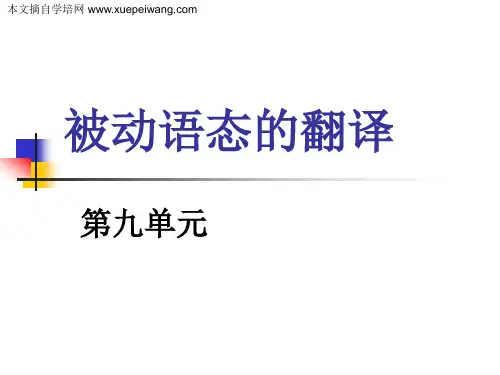
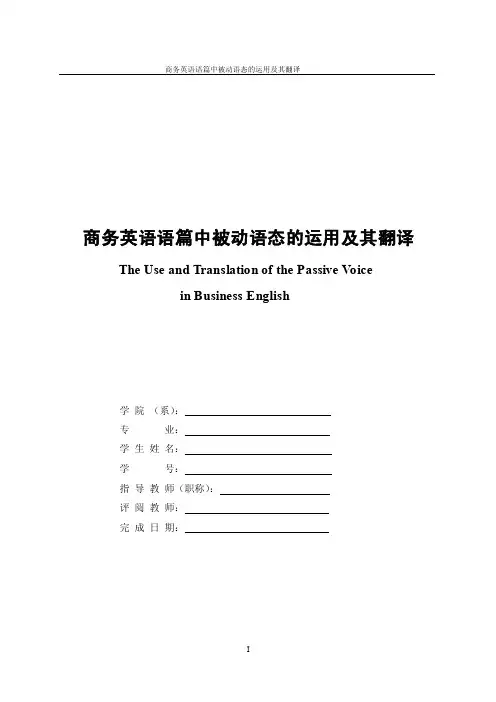
商务英语语篇中被动语态的运用及其翻译The Use and Translation of the Passive Voicein Business English学院(系):专业:学生姓名:学号:指导教师(职称):评阅教师:完成日期:I商务英语语篇中被动语态的运用及其翻译[摘要]被动语态是语言学中较为常见的语法现象。
较汉语而言,英文中使用得更为广泛,尤其是在商务英语这一实用性语体中更是有着举足轻重的地位。
本文共分四章对此课题进行研究,首先对英汉语篇中被动语态做对比分析;接着进一步探究了商务英语中被动语态的分类、功能及运用,商务英语中被动语态的大量使用实现了正式、公正、礼貌、委婉等语用功能,是合作原则与礼貌原则的体现;然后具体介绍了商务英语中被动语态的翻译,由于汉语中较少使用被动语态,因此翻译上应注重功能对等,在措辞上遵循汉语表达的同等语用功能;最后做出总结。
[关键词]商务英语;被动语态;运用;翻译IIThe Use and Translation of the Passive Voicein Business EnglishEnglish MajorAbstract: The passive voice is a common grammatical phenomenon in linguistics. Compared with the Chinese, it is used more widely in English, and it also has a pivotal position in the practical Business English language. This paper is divided into four chapters to discuss this subject. At first,we do comparative analysis of the passive voice in Chinese and English; And then further explore the classification, function and use of passive voice in English. The extensive use of passive voice has achieved formal, impartial, courteous, tactful and other pragmatic functions, which also shows the principle of cooperation and courtesy; then it specifically introduces the translation of passive voice in English. Because the passive voice is less used in Chinese, we should focus on the functional equivalence of translation that is, trying to make the Chinese wording have the same pragmatic function; At last we have a summary.Key words: Business English; passive voice; use; translation strategiesIIIContentsIntroduction (V)Chapter 1 The Comparison of Passive V oice in English and Chinese (2)1.1 The forms of passive voice (2)1.1.1 The form of passive voice in English (2)1.1.2 The form of passive voice in Chinese (2)1.2 The features of passive voice (3)1.2.1 Format (3)1.2.2 The relationship of subject and object (5)1.2.3 The mobility (5)1.3 The factors of using passive voice (5)Chapter 2 Passive V oice in Business English (6)2.1 Classification (6)2.2 Pragmatic function (6)Chapter 3 The Translation Strategies of the Passive Voice in B usiness English (9)3.1 Using passive forms (10)3.2 Using active forms (10)Conclusion (12)References (14)Acknowledgements (XIX)IVIntroductionInternational business activities are increasing in today‟s economic globalization. The English used in the introduction of technology, foreign trade, investment, foreign contracting and labor service contracts, international finance, foreign insurance, overseas investment and other fields are all called Business English. Business communication is the bridge for people to explain views and achieve cooperation, which is inseparable from the speech activities. English as a universal language in the world plays an important role in business verbal communication. Business English is a branch of the English language system, which serves for the specific international business activities. It is based on English vocabulary, basic grammar and sentence structure, but it has a unique language phenomenon and content. From the stylistic features of Business English, we can easily find there are lots of passive sentences, which are not commonly used in Chinese, so we have encountered problems in the translation. It is necessary for us to have a comparison of the differences between English and Chinese. Exploring the use of passive voice in business English discourse and its translation is good for a translator to grasp the original style, make a rational wording and protect the speakers‟interests as well as manifest their courtesy and cooperation.VChapter 1 The Comparison of Passive V oice in English and Chinese1.1 The forms of passive voicePassive voice is a common grammatical phenomenon in English which is opposed to the active voice. It composed of different tense of “to be” followed by a verb‟s past participle form and the subject is the bearer of the action. Passive voice can avoid giving others the subjective feeling, so that the text is more objective and formal and the tone will be more tactful. “English passive voice has a variety of forms, and there are strict rules for the structure and syntax. While in Chinese only one word or phrase in the passive form can show the passive voice.”(何自然,1988:42) [1]1.1.1 The form of passive voice in EnglishA. The passive voiceThe passive voice is the most common form to manifest the English passive meaning, in general, it is composed of “be + past participle”or “get / become + past participle”.The passive voice composed of “g et / become + past participle” generally refers to the result of the action rather than the action itself.It often expresses the meaning that something is finally done, something takes place suddenly or someone has a chance encounter. It can also show the “gra dation” of the state, emphasis on action process. For example:[e.g. 1] History is made by the people.The more I hear, the more I get / become troubled.B. The active form expressing the passive meaningThere are some verbs with active form in English which actually are expression of passive meaning. For example,[e.g. 2] The man is drowning = The man is being drowned.1.1.2 The form of passive voice in ChineseUnlike English passive sentence,the Chinese passive sentence doesn‟t change the form. The difference between passive sentence and active sentence lies in the “mark words of the form”. If you don‟t take the semantic level into account, there is no different sign between the form of passive sentences and the general structure of the active sentences. Therefore, the Chinese passive sentence can be also divided into two categories: passive sentence with theVInegative mark and the active form expressing passive meaning. This presentation will help us to compare it in English and Chinese. Chinese passive sentence is verb-predicate sentence and its adverbial is preposition phrase composed of “被”. The subject is the bearer of the verb, and the object is the executer. For example, “敌人被我们消灭了。
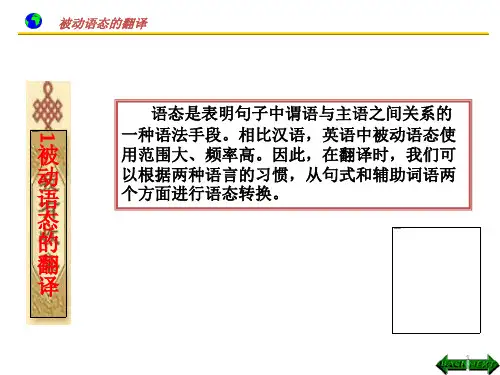
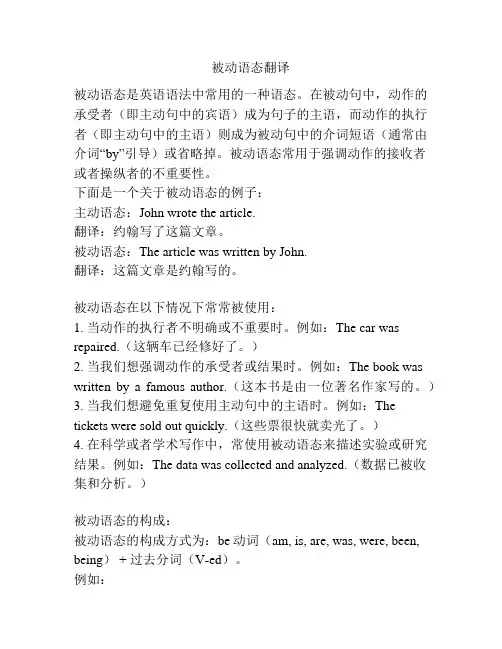
被动语态翻译被动语态是英语语法中常用的一种语态。
在被动句中,动作的承受者(即主动句中的宾语)成为句子的主语,而动作的执行者(即主动句中的主语)则成为被动句中的介词短语(通常由介词“by”引导)或省略掉。
被动语态常用于强调动作的接收者或者操纵者的不重要性。
下面是一个关于被动语态的例子:主动语态:John wrote the article.翻译:约翰写了这篇文章。
被动语态:The article was written by John.翻译:这篇文章是约翰写的。
被动语态在以下情况下常常被使用:1. 当动作的执行者不明确或不重要时。
例如:The car was repaired.(这辆车已经修好了。
)2. 当我们想强调动作的承受者或结果时。
例如:The book was written by a famous author.(这本书是由一位著名作家写的。
)3. 当我们想避免重复使用主动句中的主语时。
例如:The tickets were sold out quickly.(这些票很快就卖光了。
)4. 在科学或者学术写作中,常使用被动语态来描述实验或研究结果。
例如:The data was collected and analyzed.(数据已被收集和分析。
)被动语态的构成:被动语态的构成方式为:be动词(am, is, are, was, were, been, being) + 过去分词(V-ed)。
例如:主动语态:She opens the door.被动语态:The door is opened by her.被动语态也可以用于不同时态和不同人称,只需要根据上述构成方式进行相应的变化。
例如:主动语态:They will finish the project.被动语态:The project will be finished by them.被动语态的使用需要根据上下文和语境来决定,不适合所有情况。

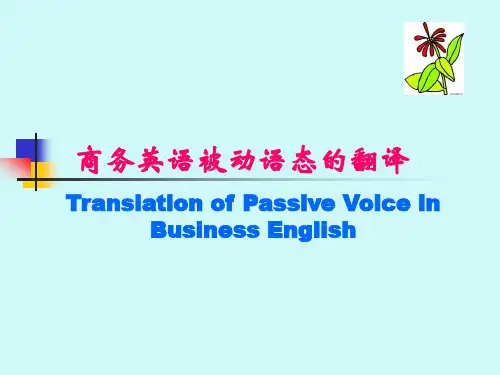
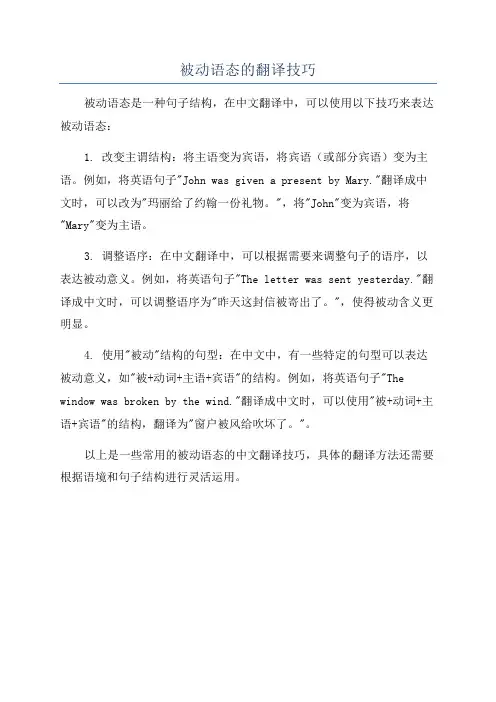
被动语态的翻译技巧
被动语态是一种句子结构,在中文翻译中,可以使用以下技巧来表达被动语态:
1. 改变主谓结构:将主语变为宾语,将宾语(或部分宾语)变为主语。
例如,将英语句子"John was given a present by Mary."翻译成中文时,可以改为"玛丽给了约翰一份礼物。
",将"John"变为宾语,将"Mary"变为主语。
3. 调整语序:在中文翻译中,可以根据需要来调整句子的语序,以表达被动意义。
例如,将英语句子"The letter was sent yesterday."翻译成中文时,可以调整语序为"昨天这封信被寄出了。
",使得被动含义更明显。
4. 使用"被动"结构的句型:在中文中,有一些特定的句型可以表达被动意义,如"被+动词+主语+宾语"的结构。
例如,将英语句子"The window was broken by the wind."翻译成中文时,可以使用"被+动词+主语+宾语"的结构,翻译为"窗户被风给吹坏了。
"。
以上是一些常用的被动语态的中文翻译技巧,具体的翻译方法还需要根据语境和句子结构进行灵活运用。
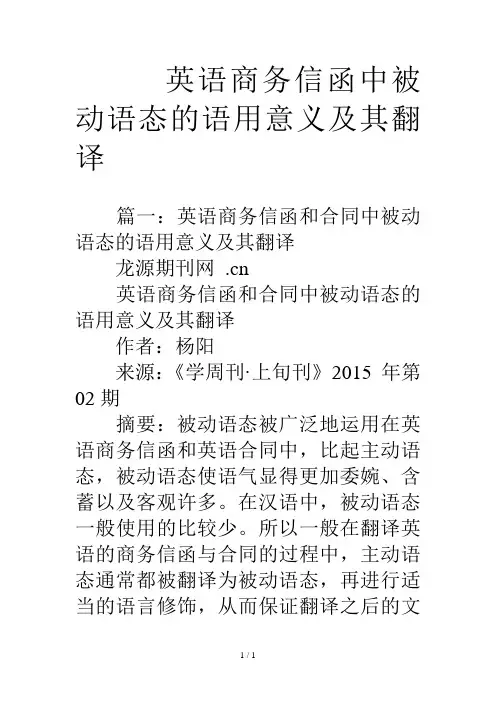
英语商务信函中被动语态的语用意义及其翻译篇一:英语商务信函和合同中被动语态的语用意义及其翻译龙源期刊网.cn英语商务信函和合同中被动语态的语用意义及其翻译作者:杨阳来源:《学周刊·上旬刊》2015年第02期摘要:被动语态被广泛地运用在英语商务信函和英语合同中,比起主动语态,被动语态使语气显得更加委婉、含蓄以及客观许多。
在汉语中,被动语态一般使用的比较少。
所以一般在翻译英语的商务信函与合同的过程中,主动语态通常都被翻译为被动语态,再进行适当的语言修饰,从而保证翻译之后的文章流畅通顺。
关键词:英语商务信函被动语态作为商务英语中比较常见的一种语法现象,有助于体现合作的礼貌与原则。
而商务英语中,被动语态的使用和汉语的被动语态的用法有着一定程度上的不同。
本文主要就针对商务英语中被动语态使用较多的商务信函与合同进行分析,从而更好地理解被动语态在商务英语中的应用与翻译状况。
一、对被动语态的认识被动语态作为动词的一种形式存在,主要是指主语是谓语动作的承受者。
若是要讲述一个客观事实就需要借助被动语态。
被动语态强调的是动作的承受者,而不是动作的发出者。
被动语态通常都是由by引导出来的,但是也有由介词by引导出来的短语,如“by bike”(骑自行车)“by bus”(坐公共汽车)等。
并且还有一些真被动、假主动的十几个常用词的用法都需要我们注意,如“so heavy to carry”表示的就是被动语态,但却不是用的“so heavy to be carried”。
针对被动语态使用的不同情况,我们一定要做到全面掌握每一种被动语态,这对于学习英语及商务信函和合同的翻译都是十分重要的。
二、英语商务信函和合同中被动语态的语用意义及其翻译(一)英语商务信函中被动语态的语用意义及其翻译被动语态作为一种重要的语言手段与工具被广泛运用在商务英语中。
与主动语态相比,被动语态不强调动作的发出者,这样在语气上就会显得委婉许多,也不会让动作的承受者感受到一种发出者将某种意思强加的强硬感觉。
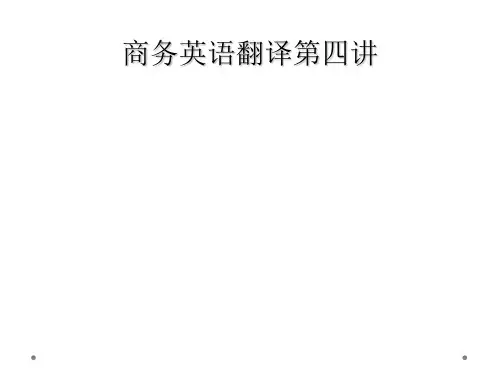
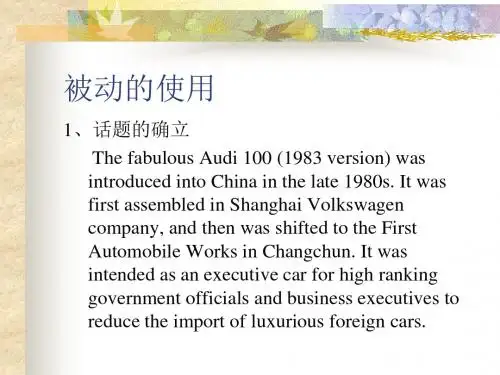
![商务英语翻译8.2 被动语态的翻译[精]](https://uimg.taocdn.com/a1e43f8a5ef7ba0d4a733bd8.webp)